Apps
Auto Added by WPeMatico
Auto Added by WPeMatico
The European Commission has set out a plan for coordinating the lifting of regional coronavirus restrictions that includes a role for digital tools in what the EU executive couches as “a robust system of reporting and contact tracing.” However it has reiterated that such tools must “fully respect data privacy.”
Last week, the Commission made a similar call for a common approach to data and apps for fighting the coronavirus, emphasizing the need for technical measures to be taken to ensure that citizens’ rights and freedoms aren’t torched in the scramble for a tech fix.
Today’s toolbox of measures and principles is the next step in its push to coordinate a pan-EU response.
“Responsible planning on the ground, wisely balancing the interests of protection of public health with those of the functioning of our societies, needs a solid foundation. That’s why the Commission has drawn up a catalogue of guidelines, criteria and measures that provide a basis for thoughtful action,” said EC president Ursula von der Leyen, commenting on the full roadmap in a statement.
“The strength of Europe lies in its social and economic balance. Together we learn from each other and help our European Union out of this crisis,” she added.
Harmonized data gathering and sharing by public health authorities — “on the spread of the virus, the characteristics of infected and recovered persons and their potential direct contacts” — is another key plank of the plan for lifting coronavirus restrictions on citizens within the 27 Member State bloc.
While ‘anonymized and aggregated’ data from commercial sources — such as telcos and social media platforms — is seen as a potential aid to pandemic modelling and forecasting efforts, per the plan.
“Social media and mobile network operators can offer a wealth of data on mobility, social interactions, as well as voluntary reports of mild disease cases (e.g. via participatory surveillance) and/or indirect early signals of disease spread (e.g. searches/posts on unusual symptoms),” it writes. “Such data, if pooled and used in anonymised, aggregated format in compliance with EU data protection and privacy rules, could contribute to improve the quality of modelling and forecasting for the pandemic at EU level.”
The Commission has been leaning on telcos to hand over fuzzy metadata for coronavirus modelling which it wants done by the EU’s Joint Research Centre. It wrote to 19 mobile operators last week to formalize its request, per Euractiv, which reported yesterday that its aim is to have the data exchange system operational ‘as soon as possible’ — with the hope being it will cover all the EU’s member states.
Other measures included in the wider roadmap are the need for states to expand their coronavirus testing capacity and harmonize tesing methodologies — with the Commission today issuing guidelines to support the development of “safe and reliable testing”.
Steps to support the reopening of internal and external EU borders is another area of focus, with the executive generally urging a gradual and phased lifting of coronavirus restrictions.
On contacts tracing apps specifically, the Commission writes:
“Mobile applications that warn citizens of an increased risk due to contact with a person tested positive for COVID-19 are particularly relevant in the phase of lifting containment measures, when the infection risk grows as more and more people get in contact with each other. As experienced by other countries dealing with the COVID-19 pandemic, these applications can help interrupt infection chains and reduce the risk of further virus transmission. They should thus be an important element in the strategies put in place by Member States, complementing other measures like increased testing capacities.
“The use of such mobile applications should be voluntary for individuals, based on users’ consent and fully respecting European privacy and personal data protection rules. When using tracing apps, users should remain in control of their data. National health authorities should be involved in the design of the system. Tracing close proximity between mobile devices should be allowed only on an anonymous and aggregated basis, without any tracking of citizens, and names of possibly infected persons should not be disclosed to other users. Mobile tracing and warning applications should be subject to demanding transparency requirements, be deactivated as soon as the COVID-19 crisis is over and any remaining data erased.”
“Confidence in these applications and their respect of privacy and data protection are paramount to their success and effectiveness,” it adds.
Earlier this week Apple and Google announced a collaboration around coronavirus contracts tracing — throwing their weight behind a privacy-sensitive decentralized approach to proximity tracking that would see ephemeral IDs processed locally on devices, rather than being continually uploaded and held on a central server.
A similar decentralized infrastructure for Bluetooth-based COVID-19 contacts tracing had already been suggested by a European coalition of privacy and security experts, as we reported last week.
While a separate coalition of European technologists and researchers has been pushing a standardization effort for COVID-19 contacts tracing that they’ve said will support either centralized or decentralized approaches — in the hopes of garnering the broadest possible international backing.
For its part the Commission has urged the use of technologies such as decentralization for COVID-19 contacts tracing to ensure tools align with core EU principles for handling personal data and safeguarding individual privacy, such as data minimization.
However governments in the region are working on a variety of apps and approaches for coronavirus contacts tracing that don’t all look as if they will check a ‘rights respecting’ box…
Poland advertised a new product to enforce #coronavirus #COVID19 quarantaine? Electronic bracelet equipped with geolocation sensor (and a microphone, apparently), for “constant monitoring instead of random checks”. https://t.co/WipDJDnLK8 pic.twitter.com/ormYjM1EyJ
— Lukasz Olejnik (@lukOlejnik) April 14, 2020
In a video address last week, Europe’s lead privacy regulator, the EDPS, intervened to call for a “panEuropean model ‘COVID-19 mobile application’, coordinated at EU level” — in light of varied tech efforts by Member States which involve the processing of personal data for a claimed public health purpose.
“The use of temporary broadcast identifiers and bluetooth technology for contact tracing seems to be a useful path to achieve privacy and personal data protection effectively,” said Wojciech Wiewiórowski on Monday week. “Given these divergences, the European Data Protection Supervisor calls for a panEuropean model “COVID-19 mobile application”, coordinated at EU level. Ideally, coordination with the World Health Organisation should also take place, to ensure data protection by design globally from the start.”
The Commission has not gone so far in today’s plan — calling instead for Member States to ensure their own efforts align with the EU’s existing data protection framework.
Though its roadmap is also heavy on talk of the need for “coordination between Member States, to avoid negative effects” — dubbing it “a matter of common European interest”. But, for now, the Commission has issued a list of recommendations; it’s up to Member States to choose to fall in behind them or not.
With the caveat that EU regulators are watching very carefully how states’ handle citizens’ data.
“Legality, transparency and proportionality are essential for me,” warned Wiewiórowski, ending last week’s intervention on the EU digital response to the coronavirus with a call for “digital solidarity, which should make data working for all people in Europe and especially for the most vulnerable” — and a cry against “the now tarnished and discredited business models of constant surveillance and targeting that have so damaged trust in the digital society”.
Powered by WPeMatico
Could avatars that show what co-workers are up to save work-from-home teams from constant distraction and loneliness? That’s the idea behind Pragli, the Bitmoji for the enterprise. It’s a virtual office app that makes you actually feel like you’re in the same building.
Pragli uses avatars to signal whether co-workers are at their desk, away, in a meeting, in the zone while listening to Spotify, taking a break at a digital virtual water coooler or done for the day. From there, you’ll know whether to do a quick ad hoc audio call, cooperate via screenshare, schedule a deeper video meeting or a send a chat message they can respond to later. Essentially, it translates the real-word presence cues we use to coordinate collaboration into an online workplace for distributed teams.
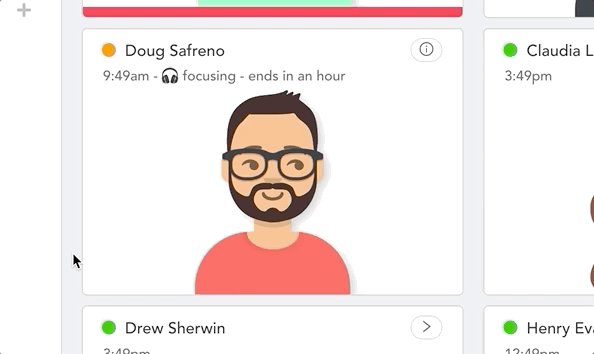
“What Slack did for email, we want to do for video conferencing,” Pragli co-founder Doug Safreno tells me. “Traditional video conferencing is exclusive by design, whereas Pragli is inclusive. Just like in an office, you can see who is talking to who.” That means less time wasted planning meetings, interrupting colleagues who are in flow or waiting for critical responses. Pragli offers the focus that makes remote work productive with the togetherness that keeps everyone sane and in sync.
The idea is to solve the top three problems that Pragli’s extensive interviews and a Buffer/AngelList study discovered workers hate:
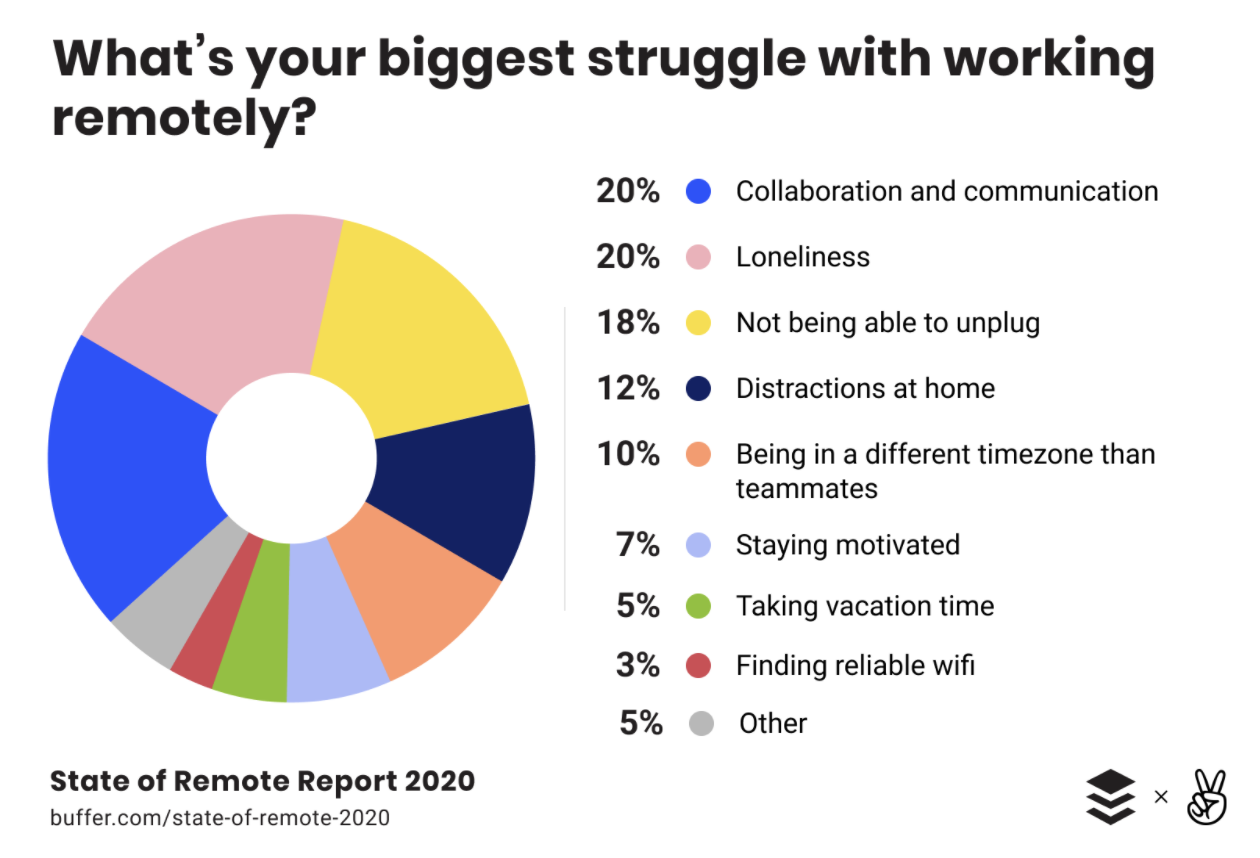
You never have to worry about whether you’re intruding on someone’s meeting, or if it’d be quicker to hash something out on a call instead of vague text. Avatars give remote workers a sense of identity, while the Pragli water cooler provides a temporary place to socialize rather than an endless Slack flood of GIFs. And because you clock in and out of the Pragli office just like a real one, co-workers understand when you’ll reply quickly versus when you’ll respond tomorrow unless there’s an emergency.
“In Pragli, you log into the office in the morning and there’s a clear sense of when I’m working and when I’m not working. Slack doesn’t give you a strong sense if they’re online or offline,” Safreno explains. “Everyone stays online and feels pressured to respond at any time of day.”

Pragli co-founder Doug Safreno
Safreno and his co-founder Vivek Nair know the feeling first-hand. After both graduating in computer science from Stanford, they built StacksWare to help enterprise software customers avoid overpaying by accurately measuring their usage. But when they sold StacksWare to Avi Networks, they spent two years working remotely for the acquirer. The friction and loneliness quickly crept in.
They’d message someone, not hear back for a while, then go back and forth trying to discuss the problem before eventually scheduling a call. Jumping into synchronous communicating would have been much more efficient. “The loneliness was more subtle, but it built up after the first few weeks,” Safreno recalls. “We simply didn’t socially bond while working remotely as well as in the office. Being lonely was de-motivating, and it negatively affected our productivity.”
The founders interviewed 100 remote engineers, and discovered that outside of scheduled meetings, they only had one audio or video call with co-workers per week. That convinced them to start Pragli a year ago to give work-from-home teams a visual, virtual facsimile of a real office. With no other full-time employees, the founders built and released a beta of Pragli last year. Usage grew 6X in March and is up 20X since January 1.
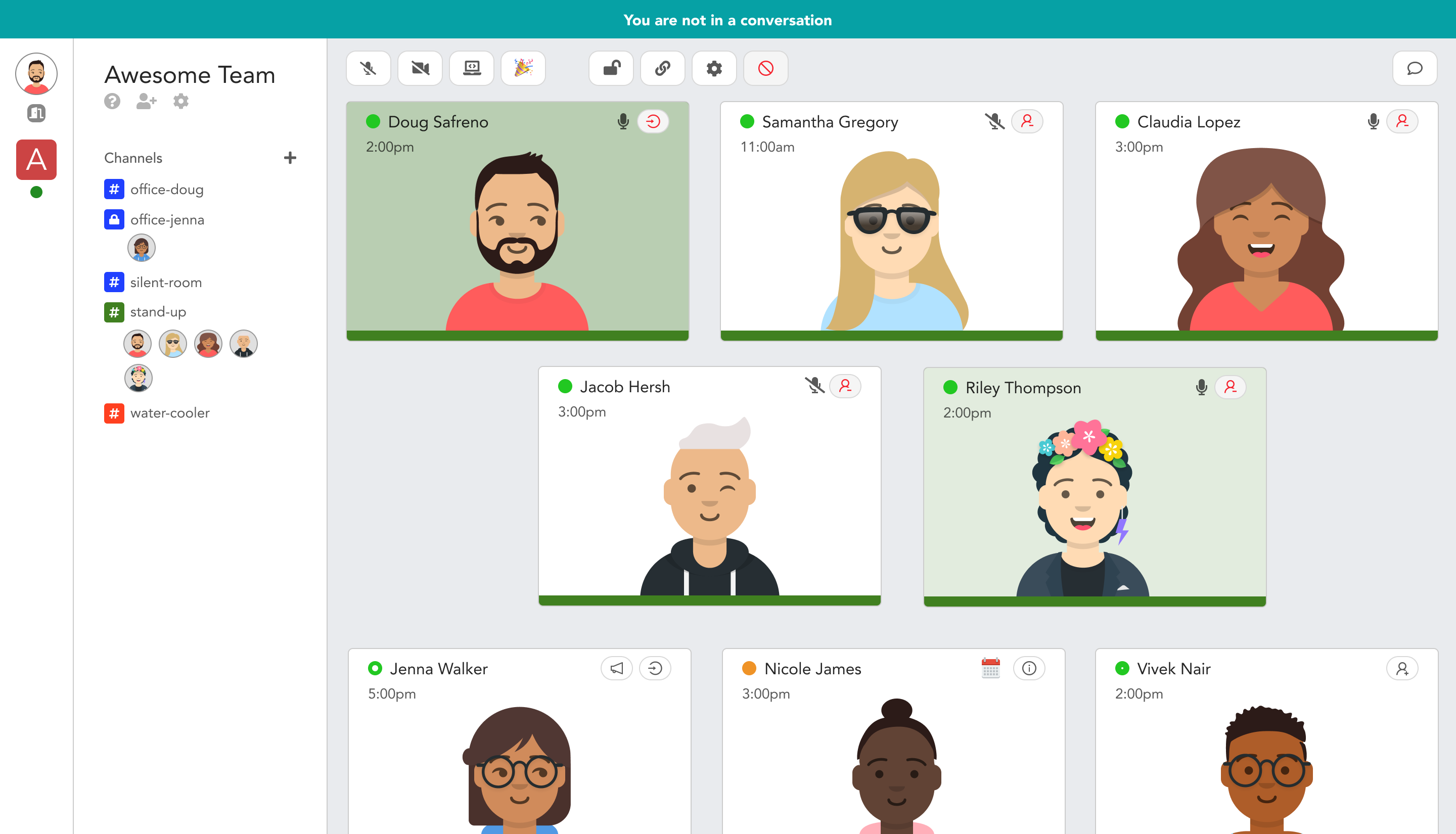
Today Pragli officially launches, and it’s free until June 1. Then it plans to become freemium, with the full experience reserved for companies that pay per user per month. Pragli is also announcing a small pre-seed round today led by K9 Ventures, inspired by the firm’s delight using the product itself.
To get started with Pragi, teammates download the Pragli desktop app and sign in with Google, Microsoft or GitHub. Users then customize their avatar with a wide range of face, hair, skin and clothing options. It can use your mouse and keyboard interaction to show if you’re at your desk or not, or use your webcam to translate occasional snapshots of your facial expressions to your avatar. You can also connect your Spotify and calendar to show you’re listening to music (and might be concentrating), reveal or hide details of your meeting and decide whether people can ask to interrupt you or that you’re totally unavailable.
![]()
From there, you can by audio, video or text communicate with any of your available co-workers. Guests can join conversations via the web and mobile too, though the team is working on a full-fledged app for phones and tablets. Tap on someone and you can instantly talk to them, though their mic stays muted until they respond. Alternatively, you can jump into Slack-esque channels for discussing specific topics or holding recurring meetings. And if you need some down time, you can hang out in the water cooler or trivia game channel, or set a manual “away” message.
Pragli has put a remarkable amount of consideration into how the little office social cues about when to interrupt someone translate online, like if someone’s wearing headphones, in a deep convo already or if they’re chilling in the microkitchen. It’s leagues better than having no idea what someone’s doing on the other side of Slack or what’s going on in a Zoom call. It’s a true virtual office without the clunky VR headset.
“Nothing we’ve tried has delivered the natural, water-cooler-style conversations that we get from Pragli,” says Storj Labs VP of engineering JT Olio. “The ability to switch between ‘rooms’ with screen sharing, video and voice in one app is great. It has really helped us improve transparency across teams. Plus, the avatars are quite charming as well.”
With Microsoft’s lack of social experience, Zoom consumed with its scaling challenges and Slack doubling down on text as it prioritizes Zoom integration over its own visual communication features, there’s plenty of room for Pragli to flourish. Meanwhile, COVID-19 quarantines are turning the whole world toward remote work, and it’s likely to stick afterwards as companies de-emphasize office space and hire more abroad.
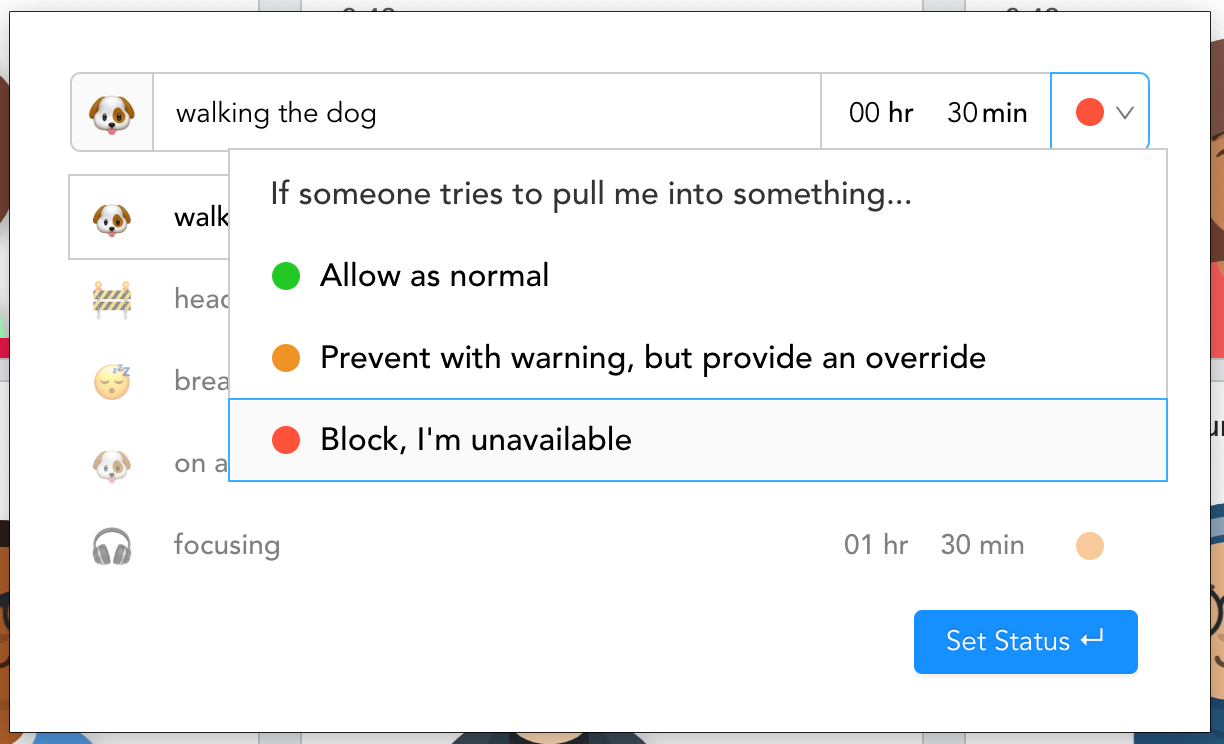
The biggest challenge will be making comprehensible enough to onboard whole teams such a broad product encompassing every communication medium and tons of new behaviors. “How do you build a product that doesn’t feel distracting like Slack but where people can still have the spontaneous conversations that are so important to companies innovating?,” Safreno asks. The Pragli founders are also debating how to encompass mobile without making people feel like the office stalks them after hours.
“Long-term, [Pragli] should be better than being in the office because you don’t actually have to walk around looking for [co-workers], and you get to decide how you’re presented,” Safreno concludes. “We won’t quit, because we want to work remotely for the rest of our lives.”
Powered by WPeMatico
Facebook’s internal R&D group has today launched a new app that lets you keep up with your close friends via your Apple Watch. The app is called Kit, or Keep in Touch, and works using a combination of QR codes and Facebook’s existing Messenger service.
According to Kit’s App Store description, you get started with the app by first scanning a QR code on your watch or by entering in an access code at fb.com/devices. You then select the Messenger contact you want to stay in touch with using Kit.
The app allows you to send a variety of messages with just one tap, including voice recordings, emoji, location sharing, scribbles and even dictation input — similar to how using iMessage from your Apple Watch works today. However, these messages are being sent over Facebook’s own Messenger service, not SMS or iMessage.
The new app also allows you to receive and respond to notifications and read your contact’s messages to you.

The idea behind the app is to allow users to stay in touch without having to pick up their phone, the App Store description explains.
While Facebook’s Messenger already offers support for Apple Watch, Kit is focused more on keeping up with close contacts only– a significant other, best friend, or family member, for example. That allows it to offer a different user interface and experience from Messenger on Apple Watch, where you have to navigate on a tiny screen to read and respond to your messages.
Kit is the latest from Facebook’s internal R&D division, NPE Team, which tests out new app concepts and rapidly iterates. So far, the NPE Team has put out a variety of new social apps like meme creator Whale, conversational app Bump, music app Aux, video app Hobbi, and most recently, Tuned, an app for couples. But only a few remain available today, as Facebook had said previously that the NPE Team apps that don’t find an audience will be quickly shut down.
To date, the NPE Team apps have launched new social experiences that weren’t tied to Facebook’s existing products. Kit, however, ties into Messenger — a move that could help it gain more of an audience, as it can tap into Messenger’s over a billion users. In addition, Kit could prove especially useful in the COVID-19 era, as people are trying not to touch their smartphones while out in public and wearing gloves. Instead, they could respond to critical messages from their close friends or family over Kit, without having to use their phone.
Kit is also notable for being the first of Facebook’s NPE Team apps to launch on Apple Watch.
Facebook doesn’t typically comment on its NPE Team experiments, and will instead point back to its original announcement that said availability would depend on the app.
According to data from Apptopia, the app hasn’t ranked yet on the App Store charts, as it’s still new. It appears to be only offered in Canada, at present.
Kit is a free download for iOS, but is for Apple Watch only.
Powered by WPeMatico
It’s a brutal time for marijuana startups. I’m hearing some are raising at one-fifth of their 2019 valuation amid rampant competition, tall taxes and slow legalization. The struggles for marijuana’s best-known startup, delivery service Eaze, continue as today it’s losing one of its top partners: $75 million-funded weed brand empire Caliva has dropped Eaze in favor of launching its own delivery system.
By partnering with Hypur banking to solve the marijuana payments legality issue, Caliva will be able to accept contactless mobile payments, unlike Eaze, which usually requires customers to pay in cash. Caliva buyers won’t have to worry about trips to the ATM, especially now during COVID-19 shelter-in-place orders, which the startup expects will boost their average order volume. Combined with verticalizing delivery in-house, plus its retail and wholesale operations, Caliva hopes it can grow its margins and survive this long winter for weed startups.

“Our mission at Caliva has always been to provide safe and easy access to plant-based solutions for health, happiness and healing,” said Caliva CEO Dennis O’Malley. “Together with Hypur, we are proud to offer our customers safe, compliant and convenient cashless payment options to improve and modernize their purchasing experience.” It hasn’t been so easy for Eaze, though.
Back in January, we reported that Eaze was in trouble, having suffered unannounced layoffs and executive departures. It burned cash on billboards, and never launched the services of a startup it acquired. There were questions about data security, and weed brands dropped Eaze due to delayed payments. It was almost out of money and in danger of vaporizing. It luckily managed to secure a $15 million bridge round to keep it alive, plus a $20 million Series D in February just before COVID-19 hit the fan, though I dread to think of the terms of that funding.
The plan for Eaze was to verticalize, buying and developing brands that it could sell through its existing delivery service to up its margins. Now it’s seeing former partner Caliva do the reverse, launching a delivery service to sell its own Fun Uncle, Deli and Caliva brands, as well as distribute other vape, edible and flower brands like Dosist and Kiva. Its menu breadth to attract customers and in-house brands to drive profits could be a winning combo. After limited pilots in SoCal, Caliva delivery is launching in LA and the Bay Area.
Unfortunately, traditional payment processors usually refuse to work with marijuana companies for fear of legal repercussions. That’s why most delivery services can’t accept credit or debit cards, or do so through sketchy legal workarounds that have led payment providers to be sued. Others like CanPay only offer ACH transfers, while Square only works with CBD sellers. “We spent time researching and evaluating all platforms that accept cannabis payments in the U.S., and found that Hypur has the best security, compliance and consumer experience” O’Malley tells me.

Although 400-person Caliva is now trying to raise a Series B, it may experience tough headwinds with shelter-in-place orders in effect in states where marijuana is legal. Stiff taxes on marijuana have meanwhile helped the black market continue to thrive, as California’s $3.1 billion in legal 2019 sales were overshadowed by an estimated $8.7 billion in illegal sales. Faster delivery and simpler payments could help. But enthusiasm for the industry has dwindled following the initial flood of entrants sought to exploit the end of prohibition. Is the Green Rush over?
Powered by WPeMatico
It takes either audacious self-confidence or reckless hubris to build a completely asocial video app in 2020. You can decide which best describes Quibi, Hollywood’s $1.75 billion-funded attempt at a mobile-only Netflix of six to 10-minute micro-TV show episodes. Quibi manages to miss every trend and tactic that could help make its app popular. The company seems to believe it can succeed on only its content (mediocre) and marketing dollars (fewer than it needs).
I appreciate that Quibi is doing something audaciously different than most startups. Rather than iterating toward product-market fit, it spent a fortune developing its slick app and buying fancy content in secret so it could launch with a bang.
Yet Quibi’s bold business strategy is muted by a misguided allegiance to the golden age of television before the internet permeated every entertainment medium. It’s unshareable, prescriptive, sluggish, cumbersome and unfriendly. Quibi’s unwillingness to borrow anything from social networks makes the app feel cold and isolated, like watching reality shows in the vacuum of space.

In that sense, Quibi is the inverse of TikTok, which feels fiercely alive. TikTok is designed to immediately immerse you in crowd-vetted content that grabs your attention and inspires you to spread your take on it to friends. That’s why TikTok has almost 2 billion downloads to date, while Quibi picked up just 300,000 on the day of its big splash into market.
Here’s a breakdown of the major missteps by Quibi, why TikTok does it better and how this new streaming app can get with the times.
Quibi feels like some off-brand cable channel, with a mix of convoluted reality shows, scripted dramas and news briefs. Imagine MTV at noon in the mid-2000s. Nothing seemed must-see. There’s no Game of Thrones or Mandalorian here. While the production value is better than what you’ll find on YouTube, the show concepts feel slapdash with novelty that quickly fades.
Chrissy Teigen as a small claims court judge? The tear-jerking “Thanks A Million” does skillfully multiply the “OMG” gratitude moment from makeover programs to happen 4X per episode. But a cooking show where blindfolded chefs have to guess what food was just exploded in their faces…(sigh)
The catalog feels like the product of TV writers being told they have 10 seconds to come up with an idea. “What would those idiots watch?” The shows remind me of old VR games that are barely more than demos, or an app built in a garage without ever asking prospective users what they need. Co-founder Jeffrey Katzenberg may have produced The Lion King and Shrek, but the app’s content feels like it was greenlit by, well, Hewlett Packard Enterprise’s leader Meg Whitman, who indeed is Quibi’s CEO.
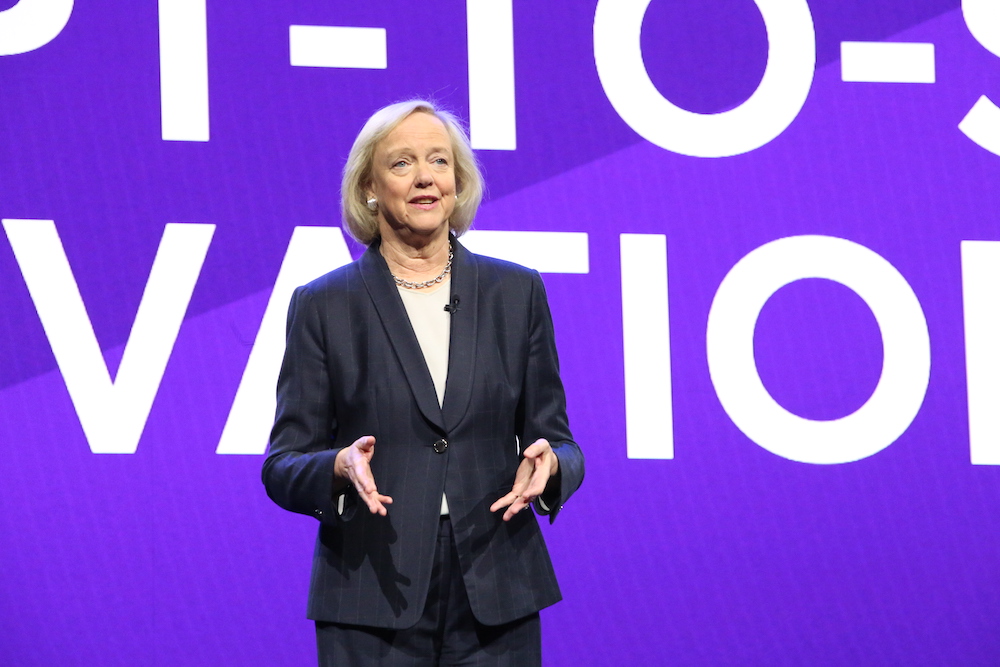
Quibi CEO Meg Whitman
Despite being built for a touch-screen interface, there’s little Bandersnatch-style interactive content so far, nor are the creators doing anything special with the six to 10-minute format. The shows feel more like condensed TV programs with episodes ending when there would be a commercial break. There’s no onboarding process that could ask which popular TV shows or genres you’re into. As the catalog expands, that makes it less likely you’ll find something appealing within a few taps.
TikTok comes from the opposite direction. Instead of what Hollywood thinks we want, its content comes straight from its consumers. People record what they think would make them and their friends laugh, surprised or enticed. The result is that with low to zero production budget, random kids and influencers alike make things with millions of Likes. And as elder millennials, Gen Xers and beyond get hooked, they’re creating videos for their peers, as well. The algorithm monitors what you’re hovering over and rapidly adapts its recommendations to your style.
TikTok is fundamentally interactive. Each clip’s audio can be borrowed to produce remixes that personalize a meme for a different demographic or subculture. And because its stars are internet natives, they’re in constant communication with their fan base to tune content to what they want. There’s something for everyone. No niche is too small.
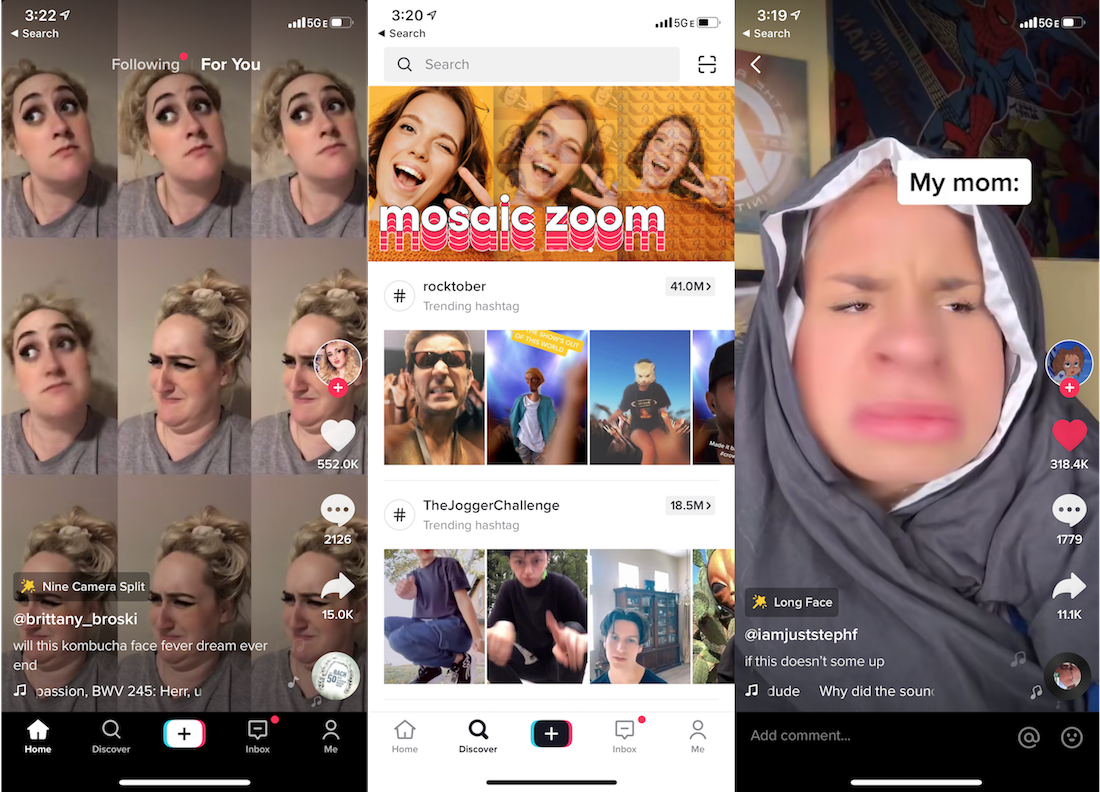
TikTok screenshots
The Fix: Quibi should take a hint from Brat TV, the Disney Channel for the YouTube generation that gives tween social media stars their own premium shows about being a grade school kid to create content with a built-in fan base. [Disclosure: My cousin Darren Lachtman is a Brat co-founder.)
Take the Chrissy’s Court model, and shift it to stars who are 20 years younger. Give TikTok phenoms like Charli D’Amelio or Chase Hudson Quibi shows and let them help conceptualize the content, and they’ll bring their legions of fans. Double-down on choose-your-own-adventures and fan voting game shows that leverage the phone’s interactivity. Fund creators that will differentiate Quibi by making it look like anything other than daytime TV. And ask users directly what they want to see right when they download the app.
This is frankly insane. Screenshots of Quibi appear as a blank black screen. That means no memes. If people can’t turn Quibi scenes into jokes they’ll share elsewhere, its shows won’t ever become fixtures of the cultural zeitgeist like Netflix’s Tiger King has. Yes, other mobile streaming apps like Netflix and Disney+ also block screenshots, but they have web versions where you can snap and share what you want. Quibi never should have structured its deals to license content from producers in a way that prevented any way to riff on or even let friends preview its content.
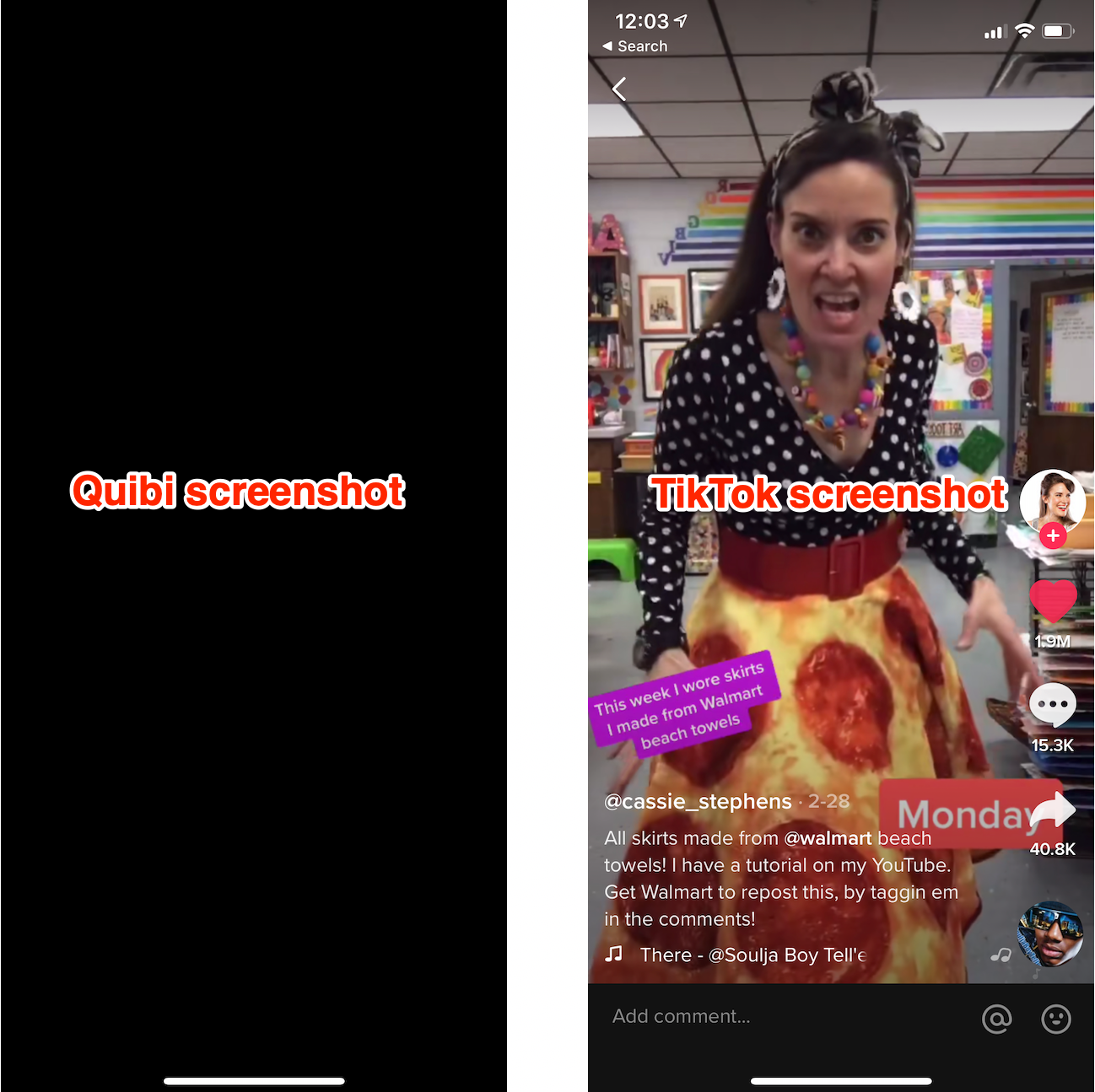
TikTok, on the other hand, defaults to letting you download any video and share it wherever you please — with the app’s watermark attached. That’s fueled TikTok’s stellar growth as clips get posted to Twitter and Instagram — and drive viewers back to the app. It has spawned TikTok compilations on YouTube, and a whole culture of remixing that expands and prolongs the popularity of trending jokes and dances.
The Fix: Quibi should allow screenshots. There’s little risk of spoilers or piracy. If its deals prohibit that, then it should offer pre-approved screenshots and video clips/trailers of each episode that you can download and share. Think of it like an in-app press kit. Even if we’re not allowed to set up the perfect screenshot for making a meme, at least then we could coherently discuss the shows on other social networks.
On mobile, you’re always just a swipe away from something more interesting. It’s like if you watched TV with your finger permanently hovering over the change channel button. Ever noticed how movie trailers now often start with a fast-forward collage of their most eye-catching scenes? Quibi seems intent on communicating prestige with its slow-building dramas like The Most Dangerous Game and Survive, which both had me bored and fast-forwarding. And that’s watching Quibi at home on the couch. While on the go, where it was designed to be consumed, slow pacing could push users with a minute or two to spare to open Instagram or TikTok instead.
None of this is helped by Quibi not auto-playing a trailer or the first episode the moment you scroll past a show on the home screen. Instead, you see a static title card for two seconds before it starts playing you an excerpt of the program. That makes it more cumbersome to discover new shows.
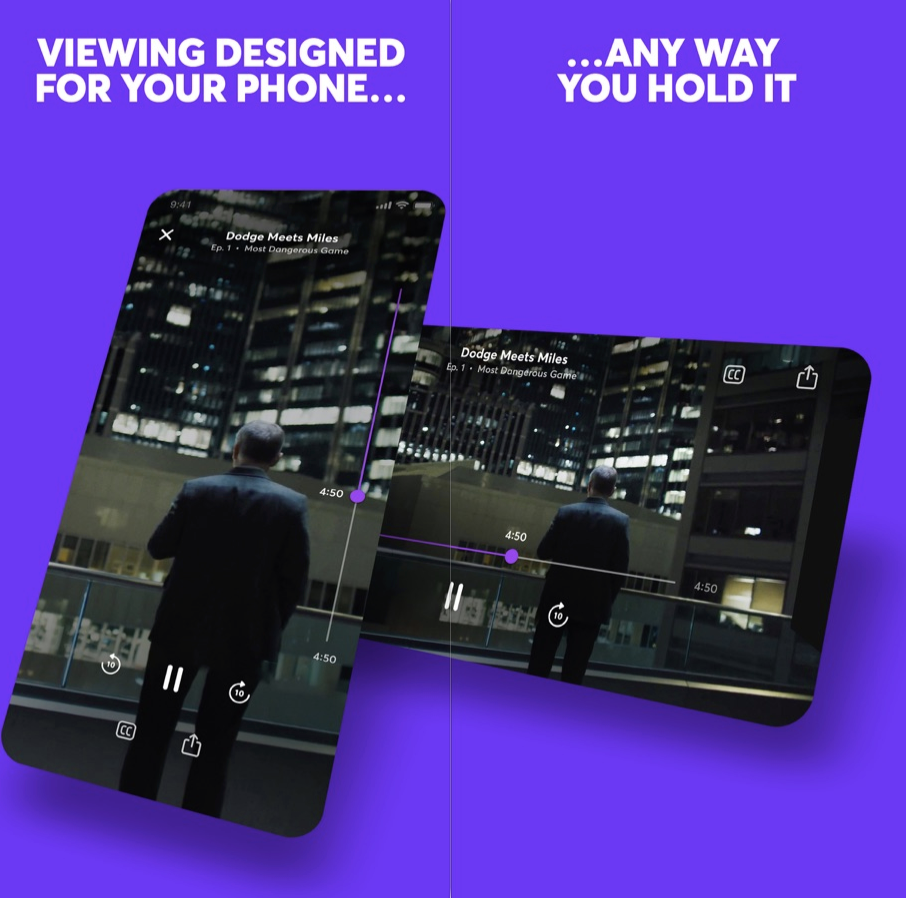
Where TikTok wins is in immediacy. Creators know users will swipe right past their video if it’s not immediately entertaining or obviously revving up to a big reveal. They grab you in the first second with smiles, costumes, bold captions or crazy situations. That also makes it easy for viewers to dismiss what’s irrelevant to them and teach the TikTok algorithm what they really want. Plus, you know that you can score a dopamine hit of joy even if you only have 30 seconds. TikTok makes Quick Bites feel like an understaffed sit-down restaurant.
The Fix: Quibi needs to teach creators to hook viewers instantly by previewing why they should want to watch. Since tapping a show’s card on the Quibi homepage instantly plays it, those teasers need to be built into the first episode. Otherwise, Quibi needs a button to view a trailer from its buried dedicated show pages to the preview card most people interact with on the home screen. Otherwise, users may never discover what Quibi shows resonate with them and teach it which to show and make more of.
Quibi neglects all its second-screen potential. No screenshotting makes it tough to discuss shows elsewhere, yet there’s no built-in comments or messaging to discuss or spread them in-app. Pasting an episode link into Twitter doesn’t even display the show’s name in the preview box. Nor do shows have their own social accounts to follow to remind you to keep watching.
There’s no way for friends to follow what you’re watching or see your recommendations. No leaderboards of top shows. Certainly no time-stamped, live-stream style crowd annotations. No synced-up co-watching with friends, despite a lack of TV apps preventing you from watching with anyone else in person unless you crowd around one phone.
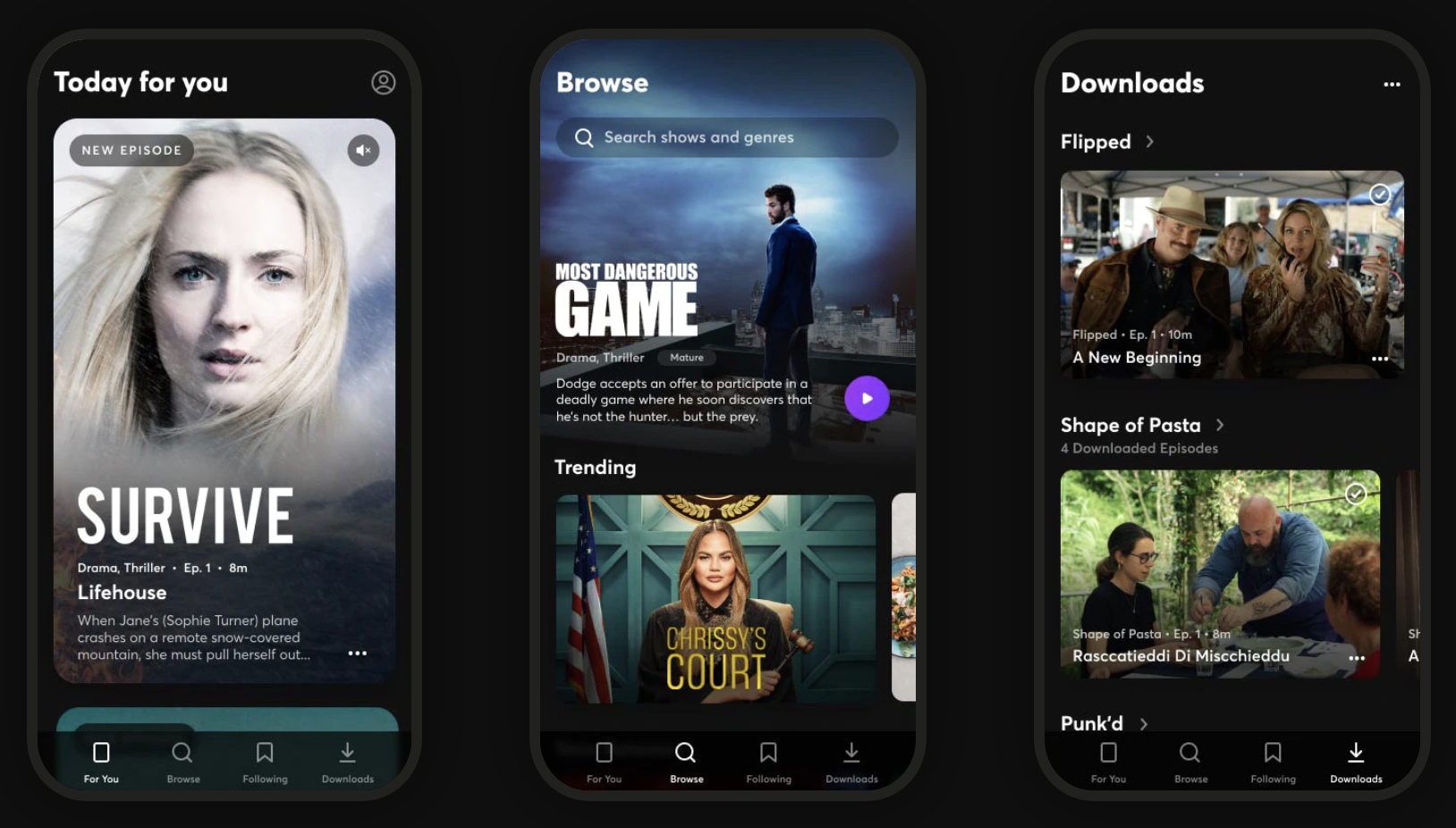
It all feels like Quibi figured advertising would be enough. It could run contests where winners get a Cameo-esque message or chat with their favorite stars. Quibi could let you share scenes with your face swapped onto actors’ heads, deepfake-style like Snapchat’s (confusingly named) Cameos feature. It could host in-app roundtables with the casts where users could submit questions. It’s like if Web 2.0 never happened.
TikTok, meanwhile, harnesses every conceivable social feature. Follow, Like, comment, message, go Live, duet, remix or download and share any video. It beckons viewers to participate in trending challenges. And even when users aren’t itching to return to TikTok, notifications from these social features will drag them back in, or watermarked clips will follow them to other networks. Every part of the app is designed to make its content the center of popular culture.
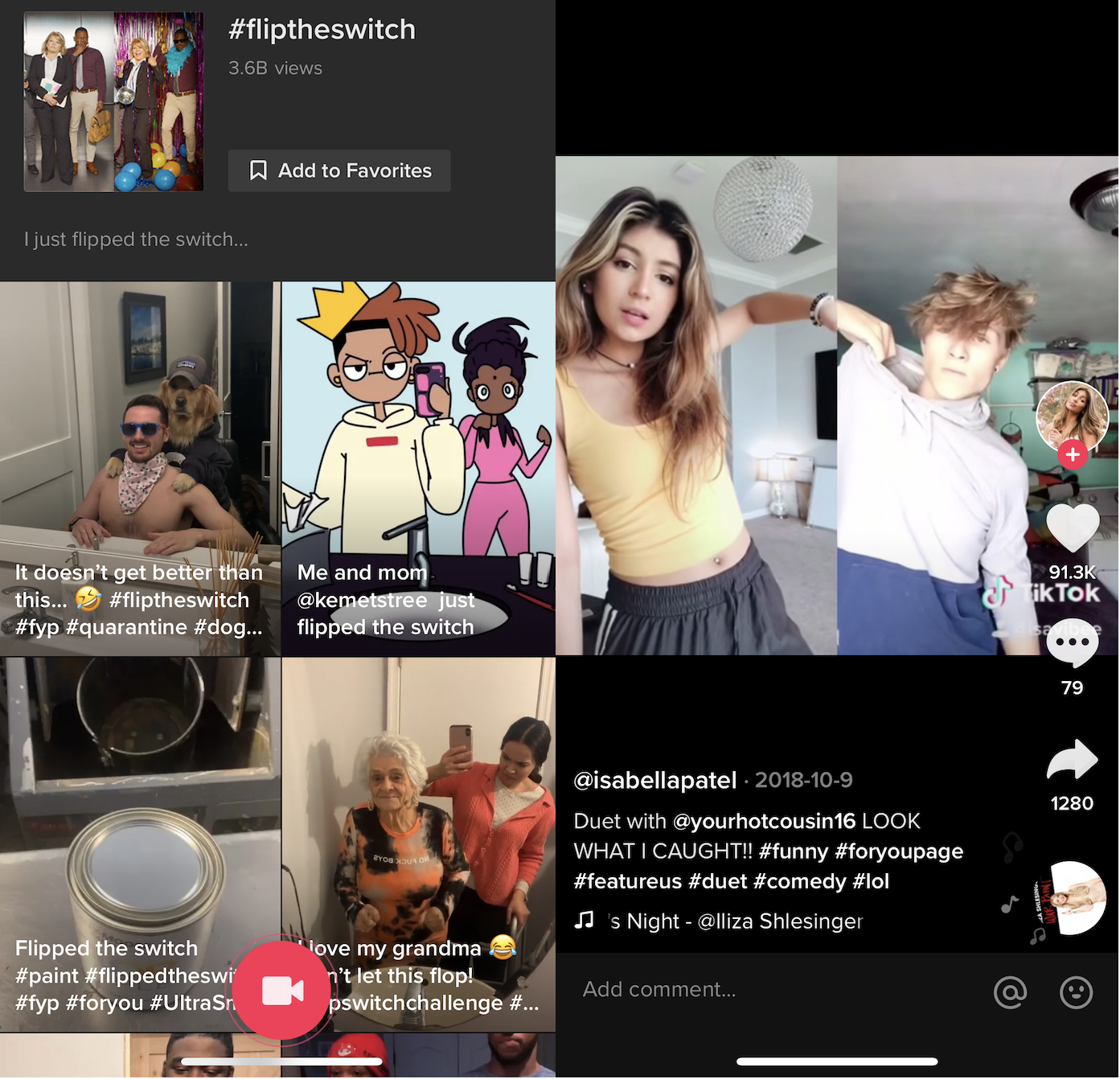
The Fix: Quibi needs to understand that just because we’re watching on mobile, doesn’t make video a solo experience. At first, it should add social content discovery options so you can see which friends opt in to share that they’re watching or view a leaderboard of the top programs. Shows, especially ones dripping out new episodes, are more fun when you have someone to chat about them with.
Eventually, Quibi should layer on in-app second-screen features. Create a way to share comments at the end of each episode that people read during the credits so they feel like they’re in a viewing community.
What’s most disappointing about Quibi is that it has the potential to be something fresh, merging classically produced premium content with the modern ways we use our phones. Yet beyond shows being shot in two widths so you can switch between watching in landscape or portrait mode at any time, it really is just a random cable channel shrunk down.

Youths act in front of a mobile phone camera while making a TikTok video on the terrace of their residence in Hyderabad on February 14, 2020 (Photo by NOAH SEELAM / AFP) (Photo by NOAH SEELAM/AFP via Getty Images)
One of the few redeeming opportunities for Quibi is using the daily episode release schedule to serialize content that benefits from suspense, as Ryan Vinnicombe aka InternetRyan notes. Bingeing via traditional streaming services can burn through thrillers before they can properly build up suspense and fan theories or let late-comers catch up while a show is still in the zeitgeist. Cliffhangers with just a day instead of a week to wait could be Quibi’s killer feature.
Suspense is also one thing TikTok fails at. Within a single video, they’re actually often all about suspense, waiting through build up for a gag or non-sequitur to play out. But creators try to rope in followers by making a multi-minute video and splitting it into parts so people subscribe to them to see the next part. Yet since TikTok doesn’t always show timestamps and surfaces old videos on its home screen, it can often be a chore to find the Part Two, and there’s no good way for creators to link them together. TikTok could stand to learn about multi-episode content from Quibi.
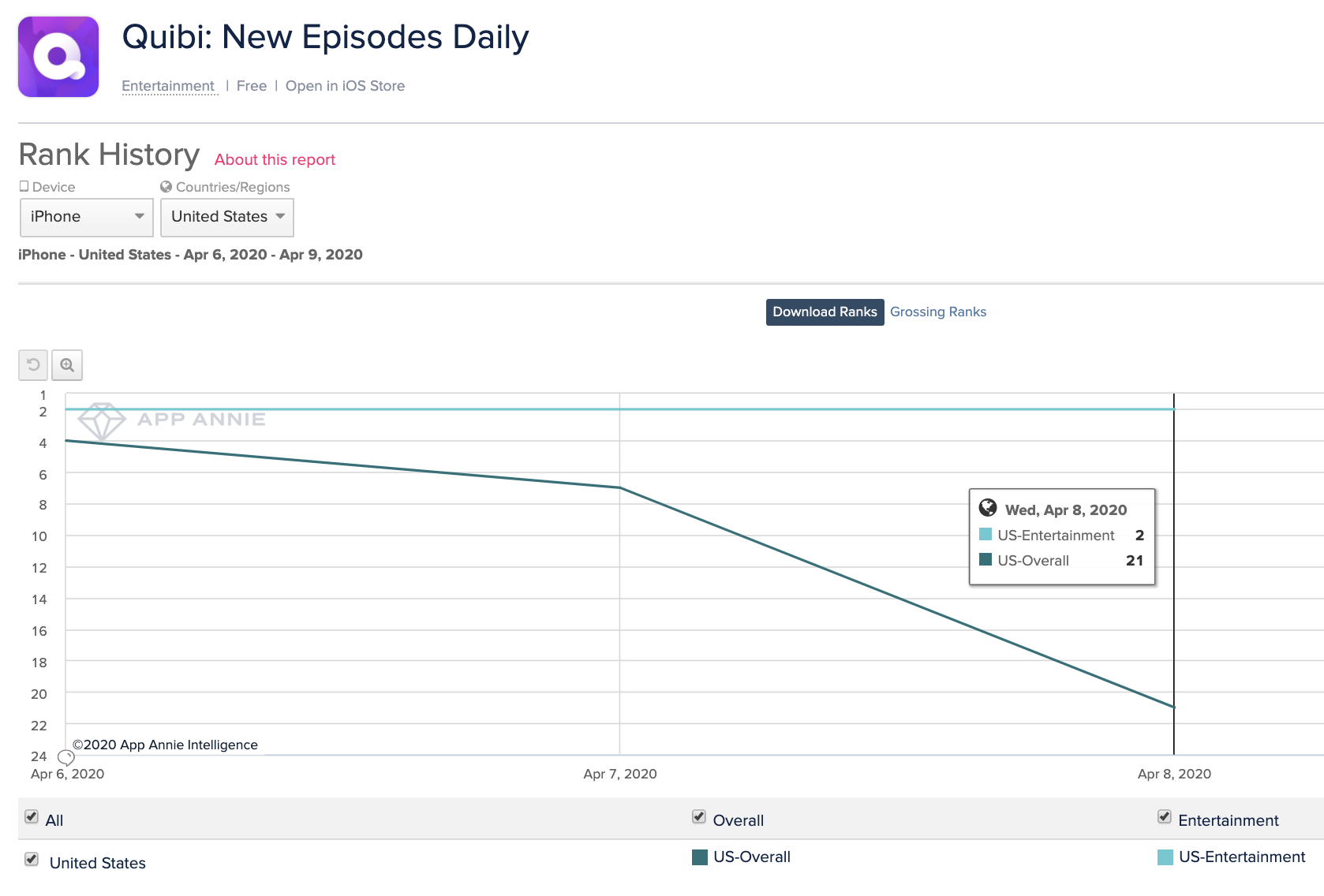
But today, Quibi feels like a minitiaturized and degraded version of what we already get for free on the web or pay for with Netflix. Quibi charging $4.99 per month with ads or $7.99 without seems like a steep ask without delivering any truly must-see shows, novel interactive experience or memory-making social moments.
Quibi’s success may simply be a test of how bad people are at cancelling 90-day free trials (hint: they’re bad at it!). The bull case is that absentminded subscribers among the 300,000 first-day downloads and some diehard fans of the celebs it’s given shows will bring Quibi enough traction to raise more cash and survive long enough to socialize its product and teach creators to exploit the format’s opportunities.
But the bear case is already emerging in Quibi’s rapidly declining App Store rank, which fell from No. 4 overall when it launched Monday to No. 21 yesterday after just 830,000 total downloads according to Sensor Tower. Lackluster content and no virality means it might never become the talk of the town, leading top content producers to slink away or half-ass their contributions, leaving us to dine on short video elsewhere.
Powered by WPeMatico
Sony said on Thursday that it is investing $400 million to secure a 4.98% stake in Chinese entertainment giant Bilibili.
10-year old Bilibili started as an animation site, but has expanded to other categories including e-sports, user-generated music videos, documentaries, and games. The service, which has amassed over 130 million users, has attracted several big investors over the years, including Chinese giants Tencent and Alibaba.
The announcement pushed Bilibili’s share up by 7.6% in pre-market trading. Sony has made the investment through its wholly-owned subsidiary Sony Corporation of America.
In a statement, Sony said the company believes China is a key strategic region in the entertainment business. BiliBili says it targets China’s Gen-Z. The vast majority of its users — about 80% — were born between 1990 and 2009.
The two companies have also agreed to pursue collaboration opportunities in the entertainment field in China, including animation and mobile game apps, they said.
You can read more about Bilibili’s business and dominance in China in my colleague Rita Liao’s piece here.
Powered by WPeMatico
We finally know just about how many subscribers Hotstar has amassed over the years in India. “Approximately 8 million.”
Disney said on Wednesday that its eponymous streaming service now has over 50 million subscribers, nearly 8 million of whom are in India, where it launched its service atop Hotstar less than a week ago.
Five-year-old Hotstar is the most popular on-demand streaming service in India with more than 300 million users. The service and its operator, Indian network Star India, were picked up by Disney as part of its $71 billion deal with Fox last year.
For years, people in the industry have been curious about Hotstar’s premium subscriber base — to no luck. Most estimates have suggested it had about 1.5 million to 2 million subscribers. Executives at rival firms have expected that figure to be lower.
In fact, a months-long analysis conducted by one streaming firm in India concluded recently that there were 2 million paying subscribers for music and video services. So 8 million is a huge milestone.
But ARPU that Disney will clock from these 8 million subscriber is going to be far lower. Disney+ Hotstar is available in India at a yearly subscription cost of about $20. (That’s the revised subscription cost. Prior to Disney+’s launch in India, Hotstar charged about $13.) The service also offers a lower-cost tier that costs under $5.5 a year.
And for that $20 a year, subscribers of Disney+ Hotstar get access to a wide-range of catalog that includes access to Disney Originals in English as well as several local languages, live sporting events, dozens of TV channels, and thousands of movies and shows, including some sourced from HBO, Showtime, ABC and Fox that maintain syndication partnerships with the Indian streaming service.
“I think everyone is still trying to sort out the right pricing. It’s true the average Indian consumer is used to far lower prices and can’t afford more. However, we need to focus on the consumers likely to buy this, who have the requisite broadband access and income, etc,” Matthew Ball, former head of strategic planning for Amazon Studios, told TechCrunch in a recent conversation.
Disney+ competes with more than three dozen international and local players in India, including Netflix, Amazon Prime Video, Times Internet’s MX Player (which has over 175 million monthly active users), Zee5, Apple TV+ and Alt Balaji, which has over 27 million subscribers.
Most of these services monetize their viewers through ads, and have kept their monthly subscription price below $3.
Powered by WPeMatico
Quibi, the short-form, mobile-focused video service that Hollywood executive Jeffrey Katzenberg first hinted at in 2017, officially launched on Monday.
After years of star-studded content announcements, not to mention $1.75 billion in funding, it might have been impossible for Quibi to live up to expectations. And indeed, it divided the hosts of the Original Content podcast.
None of us was totally won over, but Anthony and Jordan saw something to admire in Quibi’s ambition, and thought there was promise for the initial lineup of shows — particularly the reality programs like “Chrissy’s Court” and “Punk’d,” which actually seem to benefit from the constraints of the short episode format.
There are some interesting scripted titles too, but even the shows we liked — particularly the Liam Hemsworth thriller “Most Dangerous Game” — felt like they’d be better on a bigger screen, with a more traditional running time.
Darrell, meanwhile, enjoyed some of the content, but he was more convinced that the whole enterprise is a massive folly. In his view, the only way to make Quibi work is to take a looser approach to length and to bring the app to other devices.
You can listen to our review in the player below, subscribe using Apple Podcasts or find us in your podcast player of choice. If you like the show, please let us know by leaving a review on Apple. You can also send us feedback directly. (Or suggest shows and movies for us to review!)
And if you’d like to skip ahead, here’s how the episode breaks down:
0:00 Intro
0:27 “Star Trek: Picard” listener response
6:04 Quibi first impressions
Powered by WPeMatico
A new startup called twine wants to help people feel less isolated and alone. Though the project has been in the works for around six months, it’s launching at a time when people are struggling with being cut off from family, friends, neighbors, co-workers and others due to the COVID-19 outbreak and the resulting government lockdowns and self-quarantines. Described simply as a “Zoom for meeting new people,” twine is a group video chat experience where people are encouraged to have meaningful discussions that spark new friendships.
In twine, users are matched with four other partners who they’ll then have 1-to-1 conversations with for eight minutes apiece. The full gathering lasts for a total of 40 minutes, including the virtual guide portion where the ground rules are set.
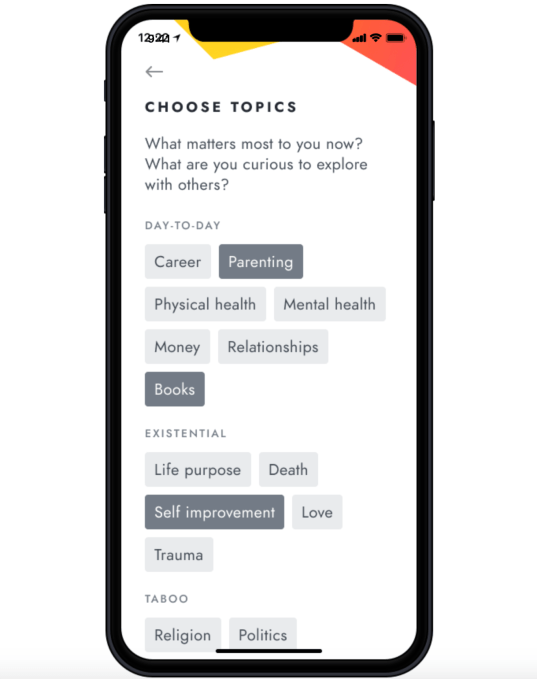
Participants choose from a library of more than 250 “deep” questions, then get matched with partners who want to explore the same topics. They then RSVP for twine’s digital gatherings in their time zone and check in when it’s time to start.
The overall experience is meant to help people find connections by skipping the small talk and going straight to what matters. But the focus is on friendships, not dating. Afterward, users are encouraged to set reminders to get back in touch and meet again in future gatherings.
There’s a hint of Chatroulette to this idea, given that users could be matched to people who are only there to disrupt the experience, in theory at least. But the company aims to reduce the potential for this sort of shock trolling by permanently banning members who are flagged for making others uncomfortable in any sort of way. We also noticed the app asks for your email, phone and ZIP code during its onboarding process, so it’s not entirely an anonymous experience.
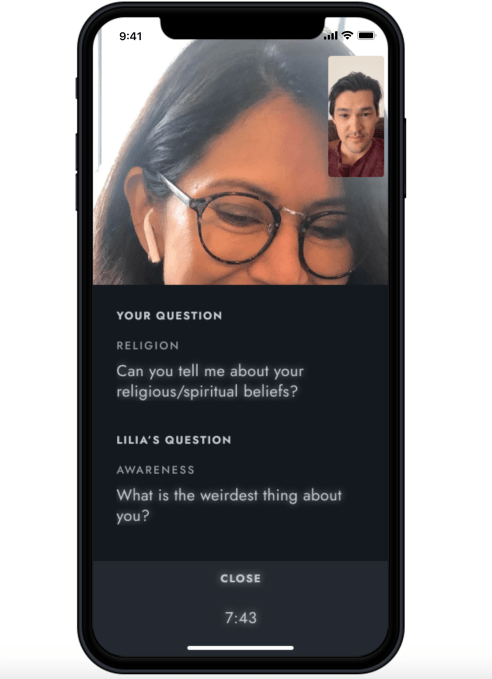
In addition, twine requires users to rate each conversation when it ends, and members have to be pre-approved before joining a chat. The company says it’s looking to move toward “real ID only” in the future to further reduce the potential for trolling.
That said, there’s still a bit of a risk in chatting openly with strangers about highly personal topics. Twine’s guidelines say that conversations are not to be discussed with others, but this is not a doctor-patient relationship with legal protections for confidentiality. It’s just a group chat app with people who may or may not be there to follow the rules.
That said, the internet is currently experiencing a rebirth of sorts, due to COVID-19. People are coming online to look for connections. Social media is actually becoming social. This is an ideal environment to test something as optimistic as twine, which at its core believes people are largely good and will use the technology appropriately.
The idea for twine comes from serial entrepreneurs Lawrence Coburn and Diana Rau. Coburn spent the last nine years as founder and CEO of mobile events technology provider DoubleDutch, which was acquired by Cvent in 2019. Rau, meanwhile, was co-founder and CEO of Veterati, a digital mentoring platform for veterans that had also leveraged 1-to-1 conversations as part of its community-building experience.
The founders already knew each other from the Georgetown entrepreneurship ecosystem. And Coburn was an advisor to Veterati, and Rau had worked at DoubeDutch, as well.
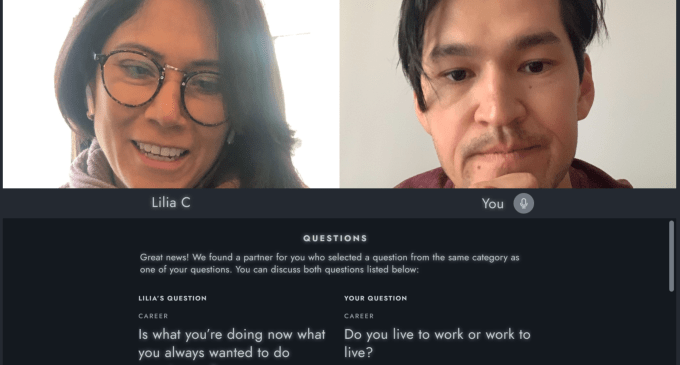
Coburn describes his vision for twine as something in between a new social network and a substitute for those who are spiritual, but not religious, in terms of helping people who want to “be better humans.” Rau says she wanted to work on twine to help end loneliness by giving people a place to explore humanity on a one-on-one basis.
The app was originally intended to connect people who would meet up in real-life gatherings, but the coronavirus outbreak shifted those plans and accelerated launch plans.
“Launching a new company during the best of times is really, really hard. During a global pandemic? Yikes!,” wrote Coburn, in a blog post about the launch. “But as the new reality settles in, it has become clear to me that the world needs twine or something like it more than ever. The macro forces that inspired Diana and I to start twine – loneliness, polarization, isolation – will only be exacerbated by social distancing. A societal loneliness that was already classified as an epidemic pre coronavirus, is about to get way, way worse,” he added.
The startup is backed by $1.4 million in seed funding, closed on March 12, led by DoubleDutch investor, Hinge Capital. Other investors from DoubleDutch have also returned to fund twine, including FJ Labs, Brand Foundry and Bragiel Brothers. Angels in the round include April Underwood (Slack), Jay Hoffmann (Rocketmiles), Scott Heiferman (Meetup) and Vishal Kapur (Screenhero).
In the future, twine aims to be subscription-based and launch real-life gatherings, as originally planned, when it’s safe to do so.
The app is currently in private beta on iOS and web. Currently, it has a waitlist of around 1,000 users, mainly from New York City and San Francisco, but twine will be available worldwide.
Powered by WPeMatico
DeHaat, an online platform that offers full-stack agricultural services to farmers, has raised $12 million as it looks to scale its network across India.
The Series A financial round for the eight-year-old Patna and Gurgaon-based startup was led by Sequoia Capital India. Dutch entrepreneurial development bank FMO, and existing investors Omnivore and AgFunder, also participated in the round. The startup, which began to seek funding from external investors last year, has raised $16 million to date and $3 million in venture debt.
DeHaat (which means village in Hindi) eases the burden on farmers by bringing together brands, institutional financers and buyers on one platform, explained Shashank Kumar, co-founder and chief executive of the startup, in an interview with TechCrunch.
The platform helps farmers secure thousands of agri-input products, including seeds and fertilizers, and receive tailored advisory on the crop they should sow in a season. “We have built a comprehensive database of crop tests to offer advice to farmers,” he said.
DeHaat, which employs 242 people, also helps them connect with 200 institutional partners to provide farmers with working capital, and when the season is over, helps them sell their yields to bulk buyers such as Reliance Fresh, food delivery startup Zomato and business-to-business e-commerce giant Udaan.
DeHaat today operates in 20 regional hubs in the eastern part of India — states such as Bihar, Uttar Pradesh, and Jharkhand — and serves more than 210,000 farmers, said Kumar.

Shashank Kumar, Amrendra Singh, Adarsh Srivastav and Shyam Sundar Singh co-founded DeHaat in 2012
The startup has developed a network of hundreds of micro-entrepreneurs in rural areas that distribute agri-input goods to farmers from their regional hubs and then bring back the output to the same hub.
“We have an app in local languages and a helpline desk that farmers, many of whom don’t own a smartphone, use to reach out to us and explain their pain points and needs,” he said.
DeHaat does not charge any fee for its advisory, but takes a cut whenever farmers use its platform to buy agri-inputs or sell their crop yields.
The startup will use the fresh capital to extend its network to 2,000 rural retail centres, on-board more micro-entrepreneurs for last-mile delivery and reach 1 million farmers by June of next year, said Kumar. DeHaat is also working on automating its supply chain and developing more sophisticated data analytics, he said.
At stake is India’s agriculture market that is worth $350 billion and serves nearly 100 million small and independent farmers, said Abhishek Mohan, VP at Sequoia Capital India, the VC fund that writes more checks than anyone else in the country.
“This industry is on the brink of a massive transformation thanks to ease of regulation, farmers getting organized and increasing penetration of smartphones. DeHaat is leveraging these trends to build the next-gen product in agricultural supply chain,” said Mohan in a statement.
“The tipping point that led to Sequoia India’s decision to partner with them was the field visit, where the farmers expressed how proud they were to be associated with a platform they felt truly worked in their favour. This impact and deep brand loyalty stems from the leadership team’s razor-sharp focus, deep empathy and fine execution,” he added.
Powered by WPeMatico